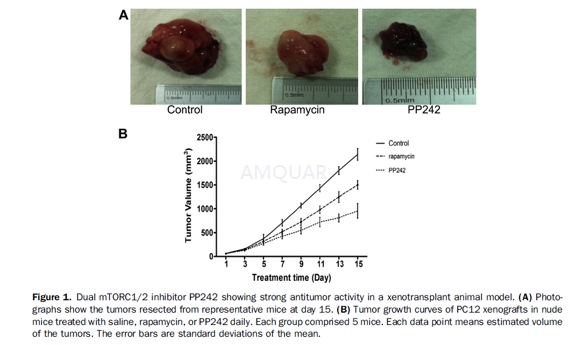-
生物活性
ATP-competitive mTORC1/mTORC2 inhibitor (IC50 = 8 nM). PP242 is the first selective inhibitor that targets the ATP domain of FRAP. This compound shows selectivity for FRAP over other PI 3-kinase (PI 3K family kinases) (IC50 values are 0.102, 0.408, 1.27, 1.96 and 2.2 μM for p110γ, DNA-PK, PI 3-kinase p110δ(p110δ), p110α and p110β respectively). Displays modest inhibition of PKCα, JAK2, PKCβI, PKCβII and RET (IC50 values are 0.049, 0.110, 0.185, 0.198 and 0.224 μM respectively). Inhibits both S6K and 4EBP1 phosphorylation; activity causes a decrease in cap-dependent protein translation. Also triggers downregulation of cFLIPS and augments TRAIL-induced apoptosis of cancer cells.
-
体外研究
-
体内研究
30% PEG400+0.5% Tween80+5% propylene glycol
-
激酶实验
In vitro kinase assays[1]
For IC50 value determinations, purifiedkinase domains were incubated with inhibitors at two-fold or four-folddilutions over a concentration range of 50μM to 0.001μMor with vehicle (0.1% DMSO) in the presence of 10μM ATP, 2.5μCiof [γ-32P] ATP and substrate. Reactions were terminated byspotting onto nitrocellulose or phosphocellulose membranes, depending on thesubstrate; this membrane was then washed five or six times to remove unboundradioactivity and dried. Transferred radioactivity was quantitated byphosphorimaging, and IC50 values were calculated by fitting the data to asigmoidal dose-response using Prism. Single concentration kinome profiling wasperformed using the Invitrogen SelectScreen assay.
-
细胞实验
Cell lines and drugs[2]
The SV-HUC‑1, RT4,BIU‑87, 5637 and T24 bladder cancer cell lines were maintained in a humidifiedatmosphere with 5% CO2 at 37˚C. The cell lines were grown inRPMI-1640 media containing fetal bovine serum according to the manufacturer'sinstructions.
PP242 was dissolved in dimethyl sulfoxide(DMSO).
Cellgrowth and proliferation assays
The Cell Counting Kit‑8 assay (CCK‑8) was used to assess effects of PP242 onbladder cancer cell growth according to the manufacturer's instructions. Cellswere incubated with PP242 at 100, 200, 500 or 1,000 nM or with DMSO (<0.5%)alone for 48 h. The absorbance was measured at a wavelength of 450 nm using aplate reader. In addition, the 5‑ethynyl‑2'‑deoxyuridine (EdU) incorporation assaywith the Cell‑Light™ EdU DNA Cell Proliferation kit was used toassess the effects of PP242 at 500 nm for 48 h on the proliferation of bladdercancer cells according to the manufacturer's instructions. All cells weretreated with 50μmol/l of EdU for 24 h at 37˚C. Following being fixed with 4%paraformaldehyde for 15 min, the cells were treated with 0.5% Triton X-100 for20 min and rinsed with PBS three times. Thereafter, the cells were exposed to100μl of 1X Apollo® reaction cocktail for 30 min and incubated with 5μg/ml ofHoechst 33342 to stain the cell nuclei for 30 min. EdU incorporation of thecells was observed under an Olympus IX‑71 invertedfluorescence microscope and images were captured.
Woundhealing migration assay
Cells were incubated in the presence orabsence of PP242 (500 nM) or with DMSO alone for 48 h. Following serumstarvation of confluent bladder cancer cells for 2 h in 24‑well plates, the media were replaced with RPMI‑1640 medium without supplementation and line‑shaped wounds were generated across the cell monolayers using asterile pipette tip. At 0 and 24 h, images of the wounded cell layers werecaptured using an Olympus IX‑71 invertedfluorescence microscope. ImageJ software was used to quantify the amount ofwound closure, which resembled the migratory potential of the cells.

-
动物实验
Xenograft Animal Tumor Model[3]
Four-week-old male BALB/c nude mice,weighing 16-20 g, were obtained. PC12 cell suspension (1 x 107/0.1mL) was injected subcutaneously into the left flanks of mice. When meanpalpable tumor volume was approximately 30 mm3 (arose within 7-10days) calculated using external calipers and the standard formula for volume V =1/2 x (width2 x length), mice were randomized into 3 groups. Eachtreatment group consisted of 5 mice.
XenograftTumor Model Treatment Protocols
Treatment was performed for 2 weeks. PP242and rapamycin were administered once a day. Mice were randomized into the followingtreatment groups: (1) control, treated by oral gavage with vehicle, 100 mLnormal saline; (2) PP242, 10 mg/kg PP242 in 100 mL by oral gavage; (3)rapamycin, 1 mg/kg rapamycin in100 mL by oral gavage. PP242 or rapamycin wassuspended in water containing 5% 1-methyl-2-pyrrolidinone and 15%polyvinylpyrrolidone as manufacturer instructions.
Assessmentof Xenograft Tumor Treatment Response and Obtaining Specimen of Tumor
Tumor size was measured by caliper of the 2perpendicular diameters every other day, and the volume of the tumor was calculatedwith the formula V = 1/2 x (width2 x length) as describedpreviously. At the end of the experiment on day 15 after injection, mice were sacrificed,and tumors were rapidly removed, weighed, and then extracted for proteinanalysis or were formalin fixed and paraffin embedded.

-
不同实验动物依据体表面积的等效剂量转换表(数据来源于FDA指南)
|  动物 A (mg/kg) = 动物 B (mg/kg)×动物 B的Km系数/动物 A的Km系数 |
|
例如,已知某工具药用于小鼠的剂量为88 mg/kg , 则用于大鼠的剂量换算方法:将88 mg/kg 乘以小鼠的Km系数(3),再除以大鼠的Km系数(6),得到该药物用于大鼠的等效剂量44 mg/kg。
-
参考文献
[1] Apsel B, Blair JA, Gonzalez B, et al. Targeted polypharmacology: discovery of dual inhibitors of tyrosine and phosphoinositide kinases. Nat Chem Biol. 2008;4(11):691-699.
[2] Zhang Z, Zhang G, Kong C, Gong D. PP242 suppresses bladder cancer cell proliferation and migration through deactivating the mammalian target of rapamycin complex 2/AKT1 signaling pathway. Mol Med Rep. 2016;13(1):333-338.
[3] Zhang X, Wang X, Qin L, et al. The dual mTORC1 and mTORC2 inhibitor PP242 shows strong antitumor activity in a pheochromocytoma PC12 cell tumor model. Urology. 2015;85(1):273 e271-277.
分子式
C16H16N6O |
分子量
308.34 |
CAS号
1092351-67-1 |
储存方式
﹣20 ℃冷藏长期储存。冰袋运输 |
溶剂(常温)
|
DMSO
>10 mg/mL |
Water
<1 mg/mL |
Ethanol
|
体内溶解度
-
Clinical Trial Information ( data from http://clinicaltrials.gov )
注:以上所有数据均来自公开文献,并不保证对所有实验均有效,数据仅供参考。
-
相关化合物库
-
使用AMQUAR产品发表文献后请联系我们



















